Can People Over 30 Still Earn Money Even If They Lack An Education
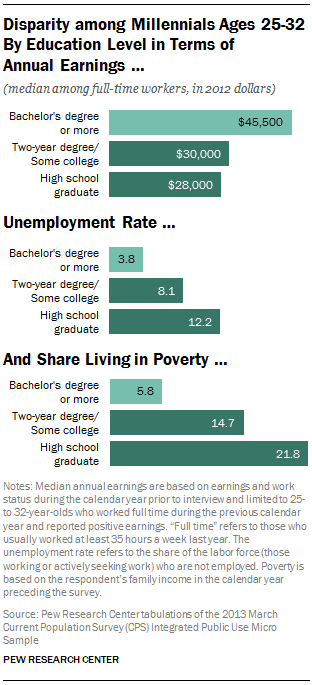 For those who question the value of higher in this era of soaring student debt and loftier unemployment, the attitudes and experiences of today's young adults—members of the and then-chosen Millennial generation—provide a compelling answer. On virtually every measure out of economical well-being and career attainment—from personal earnings to job satisfaction to the share employed full time—young college graduates are outperforming their peers with less pedagogy. And when today'due south young adults are compared with previous generations, the disparity in economic outcomes betwixt college graduates and those with a loftier school diploma or less formal schooling has never been greater in the modern era.
For those who question the value of higher in this era of soaring student debt and loftier unemployment, the attitudes and experiences of today's young adults—members of the and then-chosen Millennial generation—provide a compelling answer. On virtually every measure out of economical well-being and career attainment—from personal earnings to job satisfaction to the share employed full time—young college graduates are outperforming their peers with less pedagogy. And when today'due south young adults are compared with previous generations, the disparity in economic outcomes betwixt college graduates and those with a loftier school diploma or less formal schooling has never been greater in the modern era.
These assessments are based on findings from a new nationally representative Pew Research Center survey of 2,002 adults supplemented by a Pew Enquiry analysis of economical data from the U.S. Census Bureau.
The economical analysis finds that Millennial higher graduates ages 25 to 321 who are working full fourth dimension earn more annually—well-nigh $17,500 more than—than employed young adults holding only a loftier school diploma. The pay gap was significantly smaller in previous generations.2 Higher-educated Millennials also are more likely to exist employed full time than their less-educated counterparts (89% vs. 82%) and significantly less likely to exist unemployed (3.8% vs. 12.2%).
 Turning to attitudes toward work, employed Millennial college graduates are more than likely than their peers with a high school diploma or less educational activity to say their job is a career or a steppingstone to a career (86% vs. 57%). In dissimilarity, Millennials with a loftier school diploma or less are virtually three times as likely as higher graduates to say their work is "simply a job to get [them] past" (42% vs. 14%).
Turning to attitudes toward work, employed Millennial college graduates are more than likely than their peers with a high school diploma or less educational activity to say their job is a career or a steppingstone to a career (86% vs. 57%). In dissimilarity, Millennials with a loftier school diploma or less are virtually three times as likely as higher graduates to say their work is "simply a job to get [them] past" (42% vs. 14%).
The survey also finds that among employed Millennials, college graduates are significantly more than likely than those without any college experience to say that their didactics has been "very useful" in preparing them for work and a career (46% vs. 31%). And these better educated young adults are more than likely to say they have the necessary instruction and training to accelerate in their careers (63% vs. 41%).
But do these benefits outweigh the financial burden imposed by iv or more years of college? Amidst Millennials ages 25 to 32, the answer is clearly yeah: About nine-in-ten with at least a bachelor'due south degree say higher has already paid off (72%) or will pay off in the future (17%). Even among the two-thirds of college-educated Millennials who borrowed money to pay for their schooling, well-nigh nine-in-ten (86%) say their degrees have been worth it or expect that they will be in the future.
Of grade, the economical and career benefits of a college degree are non limited to Millennials. Overall, the survey and economical analysis consistently find that higher graduates regardless of generation are doing better than those with less education.3
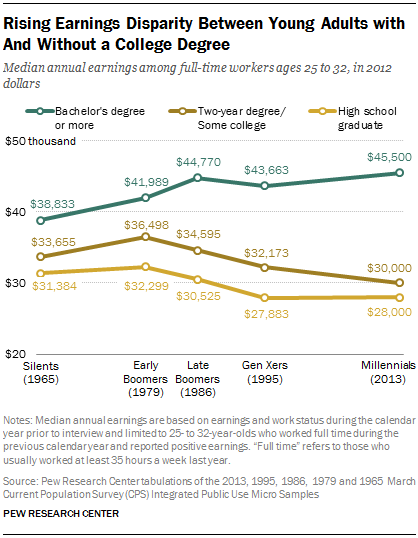 But the Pew Research study too finds that on some key measures, the largest and most striking disparities between college graduates and those with less education surface in the Millennial generation.
But the Pew Research study too finds that on some key measures, the largest and most striking disparities between college graduates and those with less education surface in the Millennial generation.
For case, in 1979 when the first moving ridge of Infant Boomers were the aforementioned age that Millennials are today, the typical high school graduate earned almost iii-quarters (77%) of what a college graduate made. Today, Millennials with simply a high school diploma earn 62% of what the typical higher graduate earns.
To be sure, the Swell Recession and the subsequent tedious recovery hit the Millennial generation particularly hard.4 Neither college graduates nor those with less education were spared. On some key measures such every bit the percentage who are unemployed or the share living in poverty, this generation of college-educated adults is faring worse than Gen Xers, Baby Boomers or members of the Silent generation when they were in their mid-20s and early on 30s.
But today's loftier school graduates are doing even worse, both in comparison to their college-educated peers and when measured against other generations of loftier school graduates at a like point in their lives.
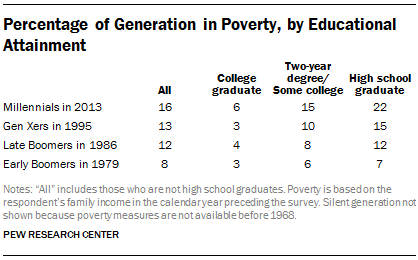 For example, among those ages 25 to 32, fully 22% with only a high school diploma are living in poverty, compared with six% of today's college-educated young adults. In dissimilarity, merely 7% of Babe Boomers who had only a high schoolhouse diploma were in poverty in 1979 when they were in their late 20s and early 30s.
For example, among those ages 25 to 32, fully 22% with only a high school diploma are living in poverty, compared with six% of today's college-educated young adults. In dissimilarity, merely 7% of Babe Boomers who had only a high schoolhouse diploma were in poverty in 1979 when they were in their late 20s and early 30s.
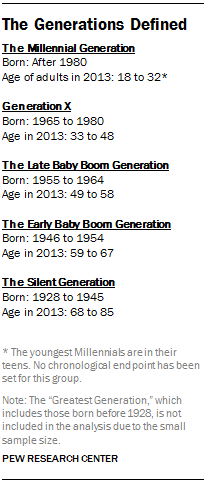 To examine the value of education in today'southward task market, the Pew Research Center drew from two complementary data sources. The commencement is a nationally representative survey conducted Oct. vii-27, 2013, of 2,002 adults, including 630 Millennials ages 25-32, the age at which virtually of these young adults will accept completed their formal education and started their working lives. This survey captured the views of today's adults toward their education, their job and their experiences in the workforce.
To examine the value of education in today'southward task market, the Pew Research Center drew from two complementary data sources. The commencement is a nationally representative survey conducted Oct. vii-27, 2013, of 2,002 adults, including 630 Millennials ages 25-32, the age at which virtually of these young adults will accept completed their formal education and started their working lives. This survey captured the views of today's adults toward their education, their job and their experiences in the workforce.
To measure how the economic outcomes of older Millennials compare with those of other generations at a comparable age, the Pew Research demographic analysis drew from data nerveless in the regime's Current Population Survey. The CPS is a big-sample survey that has been conducted monthly past the U.Southward. Census Agency for more than six decades.
Specifically, Pew analysts examined CPS data nerveless concluding yr among 25- to 32-year-olds and and then examined data among 25- to 32-year-olds in four earlier years: Silents in 1965 (ages 68 to 85 at the time of the Pew Enquiry survey and Current Population Survey); the get-go or "early on" moving ridge of Baby Boomers in 1979 (ages 59 to 67 in 2013), the younger or "late" moving ridge of Infant Boomers in 1986 (ages 49 to 58 in 2013) and Gen Xers in 1995 (ages 33 to 48 in 2013).
The Ascent of the College Graduate
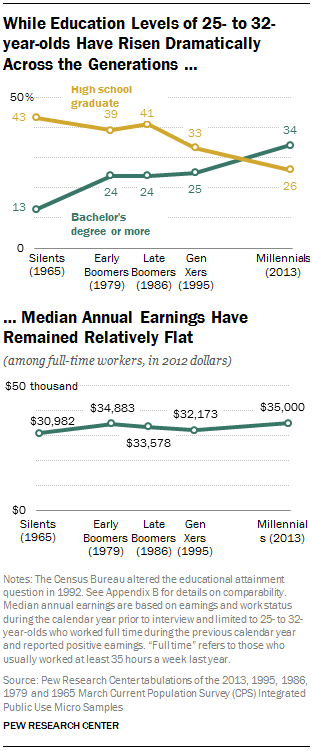 Today'due south Millennials are the all-time-educated generation in history; fully a third (34%) accept at least a bachelor's degree. In contrast, only 13% of 25- to 32-year-olds in 1965—the Silent generation—had a higher caste, a proportion that increased to 24% in the tardily 1970s and 1980s when Boomers were immature adults. In contrast, the proportion with a high school diploma has declined from 43% in 1965 to barely a quarter (26%) today.
Today'due south Millennials are the all-time-educated generation in history; fully a third (34%) accept at least a bachelor's degree. In contrast, only 13% of 25- to 32-year-olds in 1965—the Silent generation—had a higher caste, a proportion that increased to 24% in the tardily 1970s and 1980s when Boomers were immature adults. In contrast, the proportion with a high school diploma has declined from 43% in 1965 to barely a quarter (26%) today.
At the same time the share of college graduates has grown, the value of their degrees has increased. Between 1965 and last twelvemonth, the median almanac earnings of 25- to 32-year-olds with a college degree grew from $38,833 to $45,500 in 2012 dollars, nigh a $7,000 increase.
Taken together, these two facts—the growing economical render to a higher degree and the larger share of college graduates in the Millennial generation—might advise that the Millennial generation should be earning more than earlier generations of young adults.
Just they're not. The overall median earnings of today'due south Millennials ($35,000) aren't much different than the earnings of early Boomers ($34,883) or Gen Xers ($32,173) and but somewhat higher than Silents ($30,982) at comparable ages.
The Failing Value of a High School Diploma
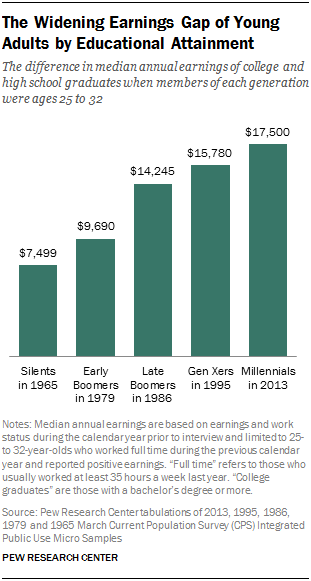 The explanation for this puzzling finding lies in another major economic trend reshaping the economic landscape: The dramatic decline in the value of a high schoolhouse pedagogy. While earnings of those with a college degree rose, the typical high school graduate's earnings fell by more $three,000, from $31,384 in 1965 to $28,000 in 2013. This decline, the Pew Research assay institute, has been large enough to most offset the gains of higher graduates.
The explanation for this puzzling finding lies in another major economic trend reshaping the economic landscape: The dramatic decline in the value of a high schoolhouse pedagogy. While earnings of those with a college degree rose, the typical high school graduate's earnings fell by more $three,000, from $31,384 in 1965 to $28,000 in 2013. This decline, the Pew Research assay institute, has been large enough to most offset the gains of higher graduates.
The steadily widening earnings gap by educational attainment is further highlighted when the assay shifts to rail the departure over fourth dimension in median earnings of college graduates versus those with a high school diploma.
In 1965, young college graduates earned $7,499 more than those with a high school diploma. Merely the earnings gap by educational attainment has steadily widened since then, and today it has more than doubled to $17,500 amongst Millennials ages 25 to 32.
Other Labor Market Outcomes
To be certain, the Slap-up Recession and painfully slow recovery have taken their toll on the Millennial generation, including the college-educated.
Immature higher graduates are having more difficulty landing work than earlier cohorts. They are more likely to exist unemployed and take to search longer for a chore than earlier generations of immature adults.
Only the motion-picture show is consistently bleaker for less-educated workers: On a range of measures, they not only fare worse than the college-educated, but they are doing worse than earlier generations at a similar age.
For example, the unemployment rate for Millennials with a college degree is more than than double the rate for higher-educated Silents in 1965 (iii.8% vs. 1.4%). But the unemployment rate for Millennials with only a loftier school diploma is even higher: 12.two%, or more than 8 percentage points more than for college graduates and near triple the unemployment charge per unit of Silents with a high school diploma in 1965.
The same pattern resurfaces when the measure shifts to the length of time the typical chore seeker spends looking for piece of work. In 2013 the average unemployed higher-educated Millennial had been looking for piece of work for 27 weeks—more than than double the time it took an unemployed college-educated 25- to 32-yr-old in 1979 to get a job (12 weeks). Once more, today's young high school graduates fare worse on this measure than the college-educated or their peers in earlier generations. According to the analysis, Millennial high school graduates spend, on average, 4 weeks longer looking for work than college graduates (31 weeks vs. 27 weeks) and more than twice as long as similarly educated early on Boomers did in 1979 (12 weeks).
Similarly, in terms of hours worked, likelihood of total-time employment and overall wealth, today's young college graduates fare worse than their peers in earlier generations. But again, Millennials without a college degree fare worse, not only in comparing to their college-educated contemporaries simply likewise when compared with similarly educated young adults in earlier generations.
The Value of a Higher Major
Equally the previous sections show, having a college degree is helpful in today's chore market. Merely depending on their major field of study, some are more relevant on the job than others, the Pew Inquiry survey finds.
To measure out the value of their college studies, all college graduates were asked their major or, if they held a graduate or professional person degree, their subject. Overall, 37% say they were social scientific discipline, liberal arts or education majors, a third (33%) say they studied a branch of science or technology and a quarter (26%) majored in business organization. The remainder said they were studying or training for a vocational occupation.
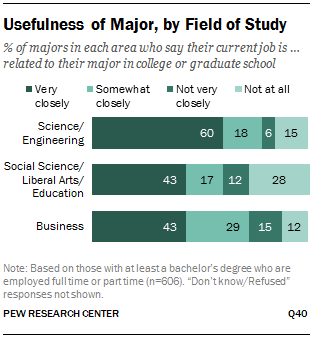 Overall, those who studied scientific discipline or engineering are the well-nigh likely to say that their current job is "very closely" related to their college or graduate field of study (threescore% vs. 43% for both social science, liberal arts or education majors and business majors).
Overall, those who studied scientific discipline or engineering are the well-nigh likely to say that their current job is "very closely" related to their college or graduate field of study (threescore% vs. 43% for both social science, liberal arts or education majors and business majors).
At the same fourth dimension, those who majored in scientific discipline or engineering are less likely than social science, liberal arts or education majors to say in response to some other survey question that they should have chosen a different major as an undergraduate to better set them for the job they wanted.
According to the survey, only virtually a quarter of science and technology majors regretted their decision (24%), compared with 33% of those whose degree is in social science, liberal arts or education. Some 28% of business majors say they would have been ameliorate prepared for the task they wanted if they had chosen a different major. (Overall, the survey found that 29% say they should have called a different major to better prepare them for their ideal job.)
Major Regrets
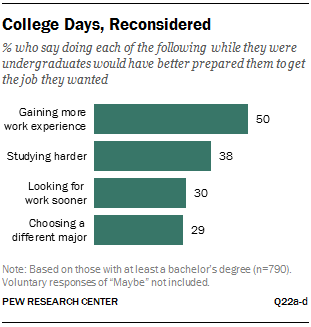 In addition to selecting a different major, the Pew Enquiry survey asked college graduates whether, while still in school, they could accept better prepared for the type of job they wanted past gaining more than work experience, studying harder or start their chore search before.
In addition to selecting a different major, the Pew Enquiry survey asked college graduates whether, while still in school, they could accept better prepared for the type of job they wanted past gaining more than work experience, studying harder or start their chore search before.
About iii-quarters of all college graduates say taking at least ane of those iv steps would accept enhanced their chances to land their ideal job. Leading the should-have-washed list: getting more work experience while even so in school. Half say taking this step would accept put them in a better position to get the kind of job they wanted. Most four-in-x (38%) regret not studying harder, while 3-in-10 say they should have started looking for a chore sooner (30%) or picked a different major (29%).
When analyzed together, the survey suggests that, amongst these items tested, just about a quarter (26%) of all college graduates have no regrets, while 21% say they should have washed at least 3 or all 4 things differently while in higher to enhance their chances for a chore they wanted.
The survey also found that Millennials are more than likely than Boomers to accept multiple regrets about their college days. Three-in-ten (31%) of all Millennials and 17% of Boomers say they should have done three or all 4 things differently in order to prepare themselves for the job they wanted. Some 22% of Gen Xers say the same.
The remainder of this report is organized in the following way. The showtime chapter uses Demography Bureau information to compare how Millennials ages 25 to 32 with varying levels of educational activity are faring economically. It also examines how economical outcomes by level of instruction take changed over time by comparison the economic fortunes of Millennials with those of similarly educated Gen Xers, Infant Boomers and Silents at comparable ages.
The second chapter is based exclusively on information from a recent Pew Research Center survey. It examines how all adults appraise the value of their education in preparing them for the workforce and specifically how these views differ past levels of education.
About the Data
Findings in this report are based mainly on data from: (1) The Electric current Population Survey and (ii) A new Pew Inquiry Center survey conducted in October 2013.
Information on Labor Market and Economical Outcomes: The labor market and economic data are derived from the Current Population Survey (CPS). Conducted jointly past the U.S. Demography Bureau and the Bureau of Labor Statistics, the CPS is a monthly survey of approximately 55,000 households and is the source of the nation's official statistics on unemployment. The CPS is nationally representative of the noncombatant noninstitutionalized population. This assay uses the Annual Social and Economical Supplement nerveless in March of each year. The March CPS features an expanded sample size (about 75,000 households in 2013) and is the basis for the widely noted Census Bureau's annual Income, Poverty, and Health Insurance Coverage estimates reported each autumn (DeNavas-Walt, Proctor and Smith ,2013). The data assay used the Academy of Minnesota Population Center'southward integrated version of the March CPS (King, Ruggles, Alexander, Alluvion, Genadek, Schroeder, Trampe, and Vick ,2010).
Survey Data: The Pew Research survey was conducted October seven-27, 2013, with a nationally representative sample of 2,002 adults historic period 18 and older, including 982 adults ages 18 to 34. A total of 479 interviews were completed with respondents contacted by landline telephone and i,523 with those contacted on their cellular phones. In order to increase the number of 25- to 34-yr-quondam respondents in the sample, additional interviews were conducted with that accomplice. Information are weighted to produce a final sample that is representative of the general population of adults in the United States. Survey interviews were conducted in English and Spanish nether the direction of Princeton Survey Research Assembly International. Margin of sampling error is plus or minus 2.seven percent points for results based on the total sample at the 95% confidence level.
Source: https://www.pewresearch.org/social-trends/2014/02/11/the-rising-cost-of-not-going-to-college/
Posted by: stellywhange39.blogspot.com

0 Response to "Can People Over 30 Still Earn Money Even If They Lack An Education"
Post a Comment